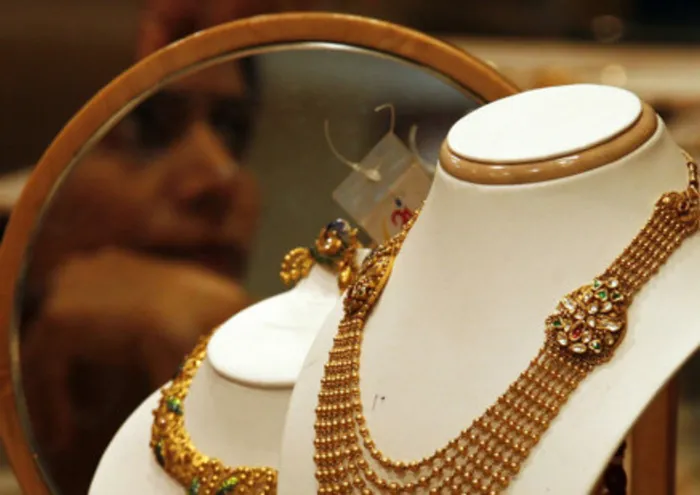Gold hits 2-week highs

A woman is reflected on a mirror inside a gold jewellery shop in the western Indian city of Ahmedabad. A woman is reflected on a mirror inside a gold jewellery shop in the western Indian city of Ahmedabad.
Gold hit two-week highs on Thursday after a coordinated effort by the world's largest central banks to unlock the credit markets and prevent a global financial meltdown gave investors confidence to cut their holdings of cash.
The US Federal Reserve, the European Central Bank and the central banks of Canada, Britain, Japan and Switzerland said they would lower the cost of existing dollar swap lines by 50 basis points from December 5, and arrange bilateral swaps to provide liquidity for other currencies.
Gold was last up 0.3 percent at $1,750.69 an ounce by 12:42 SA time, having risen to a session peak of $1,754 earlier, its highest since November 17. Gold rose 1.9 percent in November, clocking up a seventh month of gains so far in 2011, but was still 9 percent below September's lifetime high at $1,920.30.
“What matters now are statements from politicians and central bankers and so on and it's news flow rather than data flow that is driving this market,” Matthew Turner, analyst at Mitsubishi, said.
“This was bullish because it was inflationary and I think that is the distinction that gold is suffering under and that is why some of those correlations have broken down,” he said.
“Inflation is positive for base metals and equities and gold, which is when you get this risk-on correlation, whereas deflation is bad for gold and bad for base metals, so again, they correlate.”
Gold can often gain in an environment of rising price pressures as it can help protect an investment portfolio from the impact of inflation, as it gains in line with other assets.
The market has turned more bullish on the longer-term prospects for the gold price, regardless of the headwind posed by the stronger dollar or greater investor optimism, which can cut the need for gold as a safe-haven asset.
The bulk of open interest in gold call options, which give the owner the right, but not the obligation to buy the gold at a set price by a set date, in 2012 is clustered at $2,000 an ounce.
Indeed, for options expiring in late December , open interest on calls at $1,800 an ounce has risen tenfold in the space of a month, to 3,248 lots. For options on the most-active February futures contract , where a lot of interest is on bearish put options, holdings of $2,000 and $,1800 calls rose by close to 20 percent last month.
FOLLOWING STOCKS
European equities recovered from earlier losses to trade broadly flat on the day. Gold's correlation with European shares reached its most positive in a year by the end of November, trading around 65 percent, meaning gold is more likely to move in tandem with shares.
The euro steadied, pulling back from Wednesday's highs, hit after the coordinated action by the central banks. However, speculation the European Central Bank could aggressively cut rates could temper gains in the single European currency.
Gold priced in euros was last down 0.2 percent on the day at 1,295.42 euros an ounce, after having gained almost 5 percent in November, its largest monthly rise since August.
“There is a twofold impact on gold from the joint policy response from central banks. First, a substantial increase in the demand for dollar swap facilities would mean further expansion of the Fed's balance sheet, if lending is not sterilised, and would effectively be another form of easing,” wrote UBS analyst Edel Tully.
“The downward pressure this puts on the dollar is clearly to gold's benefit. Second, to the extent that the cheapening of dollar funding costs limits the possibility of a liquidity crunch, it is also beneficial for gold. We only need to look back to 2008 for a reminder that a dollar funding crisis is not gold's friend,” she said.
Gold tumbled to its weakest in nearly a month last week after declines in equities sparked a sell-off in the bullion markets to enable investors to cover losses in other markets.
Retail investors have been cautious, with dealers in Asia reporting a degree of hesitation by jewellers to buy in such a turbulent environment.
Premiums for physical delivery in Hong Kong have this week fallen to their lowest in three months, although forecasts for demand in China, the world's second-largest consumer of gold after India, anticipate continued strength.
China's gold consumption will be around 750 tonnes this year, Albert Cheng, a managing director for the World Gold Council, told an industry conference in Shanghai on Thursday.
In other precious metals, silver, which fell nearly 4 percent in November, was last up 1.0 percent on the day at $33.15 an ounce.
Platinum was flat on the day at $1,551.24 an ounce, while palladium rose 1 percent to $612.22 an ounce. - Reuters